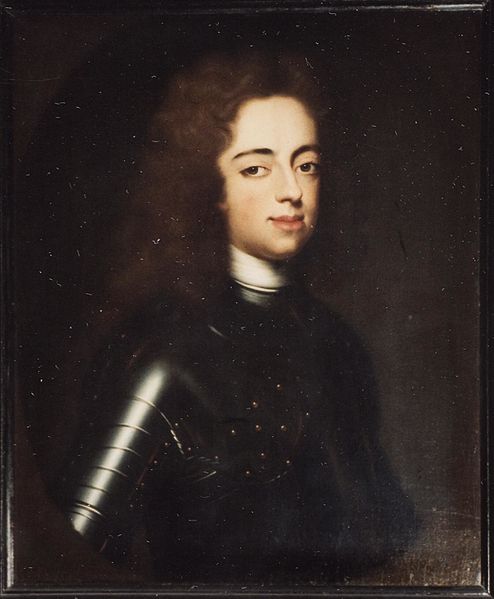by Susan Flantzer © Unofficial Royalty 2018

Johan Willem Friso, Prince of Orange; Credit – Wikipedia
Until September 8, 2022, Johan Willem Friso, Prince of Orange and his wife Princess Marie Luise of Hesse-Kassel held the distinction of being the most recent common ancestors to all currently reigning European monarchs. Louis IX, Landgrave of Hesse-Darmstadt and his wife Countess Palatine Caroline of Zweibrücken became the most recent common ancestors of all current hereditary European monarchs on September 8, 2022 after Queen Elizabeth II of the United Kingdom, who was not a descendant, died and her son, Charles III, a descendant through his father, became king.
The only surviving son and the third of the nine children of Hendrik Casimir II, Prince of Nassau-Dietz and Stadtholder of Friesland and Groningen and Henriëtte Amalia of Anhalt-Dessau, Johan Willem Friso was born on August 14, 1687, in Dessau, Principality of Anhalt, now in the German state of Saxony-Anhalt. His grandmothers Albertine Agnes and Henriëtte Catharina were daughters of Fredrik Hendrik, Prince of Orange and granddaughters of Willem I (the Silent), Prince of Orange. Upon his father’s death in 1696, nine-year-old Johan Willem Friso became Prince of Nassau-Dietz and Stadtholder of Friesland and Groningen, two of the seven provinces of the Dutch Republic.
Johan Willem Friso had eight siblings:
- Willem George Friso (1685–1686), died in infancy
- Henriëtte Albertine (1686–1754)
- Maria Amalia (1689–1771)
- Sophia Hedwig (1690–1734), married Karl Leopold, Duke of Mecklenburg-Schwerin, no children
- Isabella Charlotte (1692–1757), married Christian, Prince of Nassau-Dillenburg, no children
- Johanna Agnes (1693–1765)
- Louise Leopoldina (1695–1758)
- Henriëtte Casimira (1696–1738)
At the time of Johan Willem Friso’s birth, his first cousin once removed Willem III was Prince of Orange and Stadtholder (Governor) of five of the seven provinces of the Dutch Republic. Willem III had married his English first cousin Mary, the elder surviving child of King James II of England. After the Glorious Revolution of 1688 which deposed King James II, Willem and Mary jointly ruled England as King William III and Queen Mary II. However, the couple had no children. Mary II died in 1694 and William (Willem) III died in 1702. Upon William’s death, Mary’s younger sister succeeded as Queen Anne in England. However, in the Dutch Republic and the Principality of Orange, which had only male succession, the legitimate male line of Willem I (the Silent), Prince of Orange became extinct.
Johan Willem Friso claimed succession in the five provinces of the Dutch Republic that William (Willem) III had held as well as to the title Prince of Orange. However, the five provinces over which Willem III had ruled as Stadtholder – Holland, Zeeland, Utrecht, Gelderland, and Overijssel – all suspended the office of Stadtholder after his death. A dispute arose between Johan Willem Friso and Friedrich I, King in Prussia, also a grandson of Frederik Hendrik, Prince of Orange, over the Principality of Orange, located in France. Friedrich I eventually inherited the land and ceded the land to France in 1713. However, the title Prince of Orange continued to be used in the Dutch Republic. Eventually, when the Netherlands became a kingdom, the Prince of Orange became the title for the heir apparent to the throne. The Netherlands has had absolute primogeniture since 1983, meaning the eldest child is the heir regardless of gender. In 2013, upon the succession of King Willem-Alexander to the Dutch throne, his eldest child Princess Catharina-Amalia became the heir apparent and the Princess of Orange.

Johan Willem Friso, Prince of Orange; Credit – Wikipedia
In 1707, 20-year-old Johan Willem Friso became a general in the Dutch army and took part in the War of the Spanish Succession. He was almost killed on two occasions and his mother Henriëtte Amalia of Anhalt-Dessau realized that her son needed an heir. She started searching for a bride and soon gave him a choice of two German princesses. Within a week, Johan Willem Friso became engaged to Marie Luise of Hesse-Kassel. They were married on April 26, 1709, in Kassel.
Marie Luise and Johan Willem Friso had two children:
- Princess Amalia of Nassau-Dietz (1710 – 1777), married Friedrich, Hereditary Prince of Baden-Durlach, had two sons including Karl Friedrich, Grand Duke of Baden
- Willem IV, Prince of Orange (1711 – 1751), married Anne, Princess Royal, daughter of King George II of Great Britain, had three children including Willem V, Prince of Orange

Marie Luise and her two children, circa 1725; Credit – Wikipedia
In July 1711, Johan Willem Friso traveled from the battlefields of the War of the Spanish Succession to The Hague to meet with King Friedrich I of Prussia about their succession dispute. To cross the Hollands Diep, a wide river in the Netherlands, Johan Willem Friso and his carriage traveled on a ferry. The captain had trouble with the sails and suddenly a great gust of wind filled the sails, the ferry capsized and Johan Willem Friso drowned at the age of 23 on July 14, 1711. His body was found floating in the river eight days later.

The drowning of Johan Willem Friso; Credit – Wikipedia
At the time of his death, Johan Willem Friso’s wife Marie Luise was pregnant with her second child. Six weeks later, she gave birth to a son who immediately became Willem IV, Prince of Orange. Marie Louise served as regent for her son from 1711 until he reached his majority in 1731. On February 25, 1712, more than seven months after his death, Johan Willem Friso was buried at the Grote of Jacobijnerkerk in Leeuwarden, Friesland now in the Netherlands, where sixteen members of Nassau-Diez family – six Stadtholders of Friesland, their spouses and children – are buried.

Grote of Jacobijnerkerk; Photo Credit – Wikipedia
This article is the intellectual property of Unofficial Royalty and is NOT TO BE COPIED, EDITED, OR POSTED IN ANY FORM ON ANOTHER WEBSITE under any circumstances. It is permissible to use a link that directs to Unofficial Royalty.
